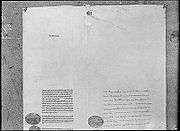Treaty of Thapathali
This article does not cite any sources. (August 2021) |
| Treaty of Thapathali(1856) | |
|---|---|
 | |
| Signed | 24 March 1856 (Chaitra 3, 1912 B.S.) |
| Location | , Kathmandu, Nepal |
| Effective | 24 March 1856 |
The Treaty of Thapathali (Chinese: 藏尼條約) was a treaty signed between the Tibetan government of Ganden Phodrang and the Kingdom of Nepal in Thapathali Durbar in Kathmandu, the capital of Nepal, following the Nepalese–Tibetan War. In January 1856, a representative group of Tibet came to Kathmandu for discussion of the treaty. After a long discussion, the representative group ultimately signed in Thapathali a treaty on 24 March.
Failure of first attempt[]
A meeting of delegation teams was called in Shikarjong but no decision was made. Nepali delegation team returned as they were to discuss with prime minister, Jung Bahadur Rana. In the meeting with Tibetan delegation, Jung Bahadur demanded one crore rupees for expenses of war and for returning the Tibetan land captured by Nepal. It was very hard for Tibetan delegation to make such a decision so Kaji Til Bikram was sent to Sikarjong along with the Tibetan in September. The ambassador of China replied with proud that he can give four lakhs rupees for war expenses and five lakhs rupees as penantly for the destruction of Nepalese troops in Lhasa. The ambassador also replied that the Tibet is a state of China and the Emperor gave it to Nuns only for religious purpose so Tibet was not subjected to give even one palm length of land to Nepal; if Nepal did not returned immediately from Tibet then Nepal must be ready to fight war with China. As Nepalese were not in support of this condition, the attempt of Treaty failed.
Second attempt and its Terms[]
- Tibet would have to pay 10,000 Nepalese rupees to the Nepalese Government every year.
- Tibet and Nepal agreed to regard the Chinese Emperor as their sovereign. If any foreign country attacked Tibet, Nepal had to aid Tibet. In case Nepal were attacked, the Tibetan government had to preserve the Nepalese wealth and transfer it to the safest place in Tibet. The expenditure of this transfer would have to be paid by Tibet for first two months, and then by Nepal after that.
- In trade between Tibet and Nepal, Tibet would not impose custom duties on Nepalese products. Tibetan duties imposed on Nepalese products up to the time of the treaty would be forgiven.
- The Tibetan government had to return all prisoners of war and arms of Nepal. The Nepalese government had to return prisoners of war and yaks taken during the war.
- For the care of Nepalese businessman, henceforth a Courtier (भारदार) would be appointed instead of Nayak(नायक) as a representative.
- All Nepalese are allowed to do business in Tibet without any hindrance. With exception of armed soldiers, all Nepalis are allowed to travel freely in Tibet.
- Nepali representatives would not interfere in Tibet's internal affairs, and in case of internal dispute within Nepal, the Tibetan government would not interfere. In case of dispute between a Tibetan and a Nepali, both governments would appoint one representative each for settlement of the dispute. The penalty paid by the Tibetan or Nepali to resolve the dispute would be given to the Tibetan government and Nepali government respectively.
- If any murderer escaped from one country and resides in the other country, the latter will extradite the culprit to the concerned government.
- If any citizen of one country steals from the citizens of the other, the former government shall make all the provisions for returning materials and punishing the culprit.
See also[]
- Thapathali Durbar
- History of Nepal
- Tibet under Qing rule
- Sino-Nepalese War
- Nepalese–Tibetan War
- China-Nepal relations
References[]
- Treaties concluded in 1856
- Treaties of Nepal
- Treaties of Tibet
- 1850s in Tibet
- 19th century in Nepal
- Nepal–Tibet relations
- 1856 in Nepal